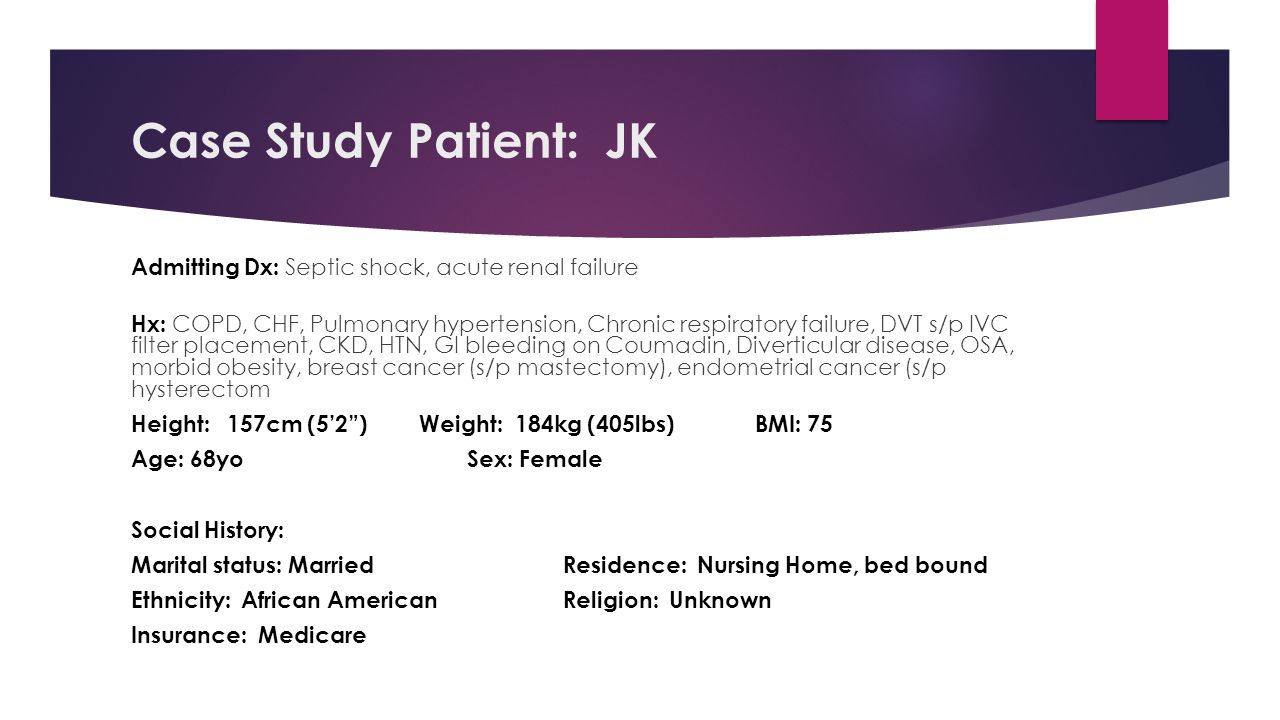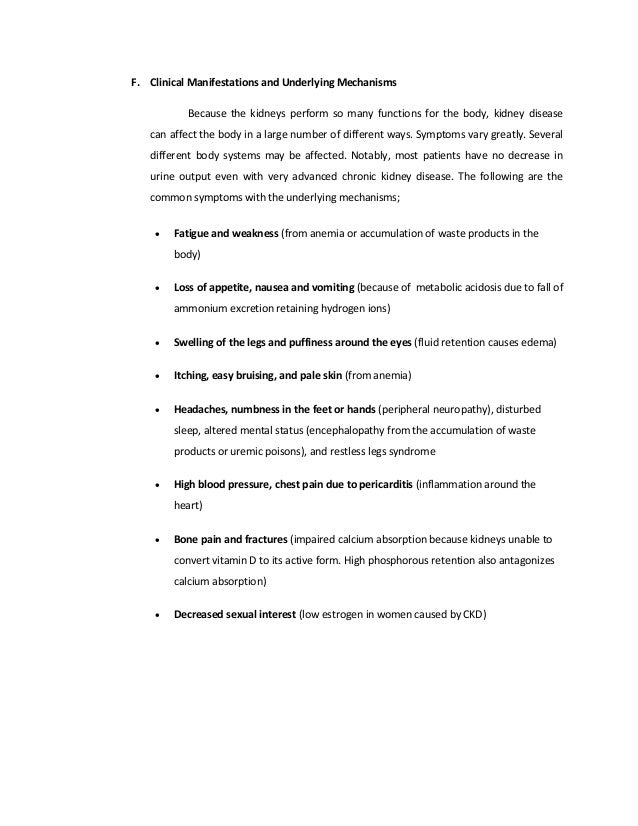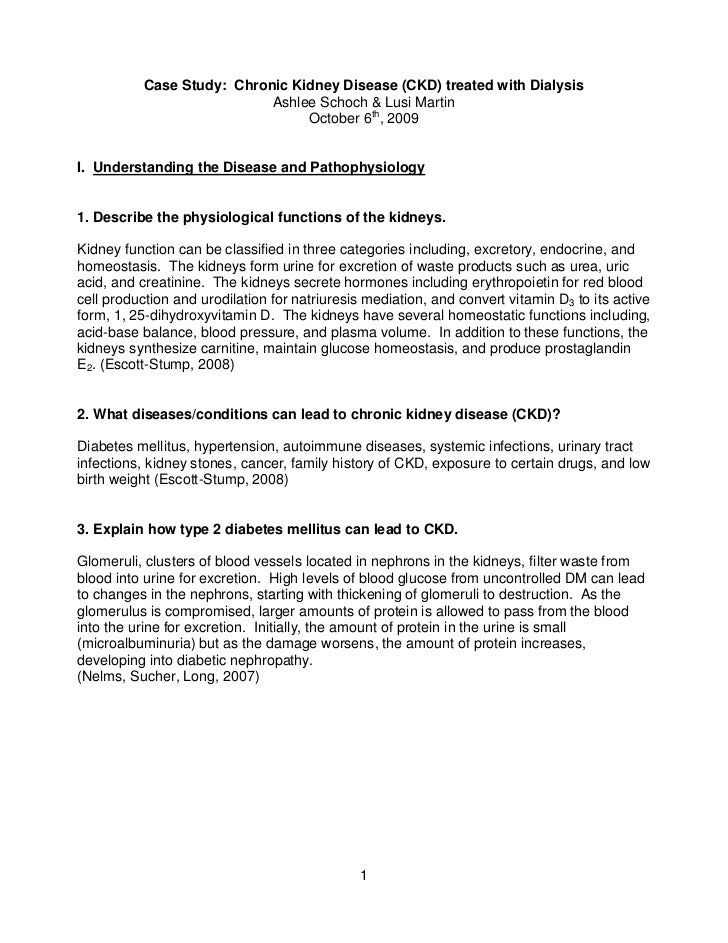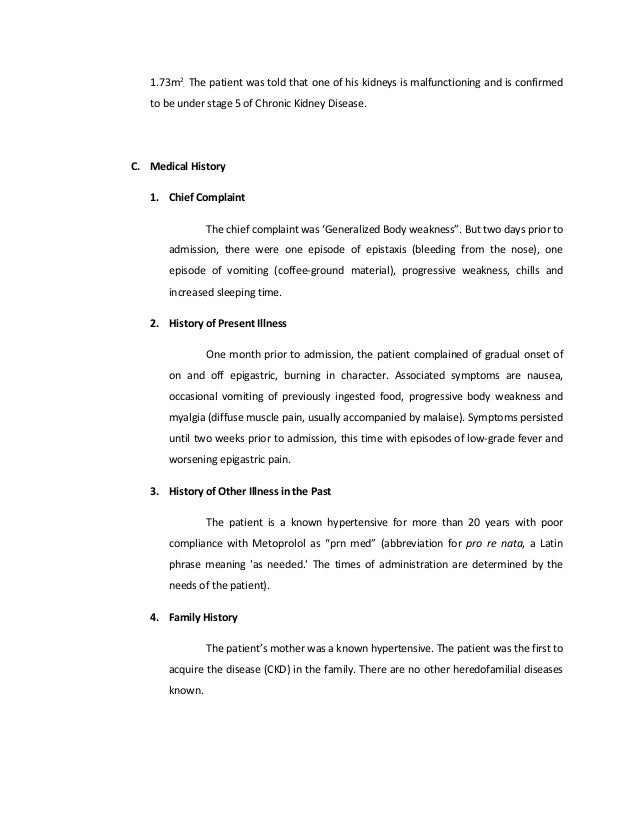Case study of patient with chronic kidney disease
Start studying Chronic Kidney Disease Case Study. Learn vocabulary, terms, and more with flashcards, games, and other study tools.

The tubules, which are permeable to urea, normally reabsorb little urea. However, as GFR decreases, more urea is reabsorbed.

Although elevated serum levels of urea nitrogen alone can indicate other abnormalities, such as dehydration, elevation of serum levels of both urea nitrogen and creatinine indicates kidney failure. The serum urea nitrogen—creatinine ratio normal This slightly decreased ratio could reflect fluid overload from the CKD or an undiagnosed liver disease, because J.
Proteinuria and hematuria are associated with glomerulonephritis and result from damage of the glomeruli with the resultant increased permeability.

Albumin is a sensitive indicator of CKD related to diabetes, glomerular disease, and hypertension. Uric acid is an end product college admission essay eating disorder purine metabolism that is filtered in the glomeruli and secreted into the distal tubule.
This elevated level of uric acid increased J. The peritubular capillary endothelium in the kidneys produces erythropoietin, which is needed to stimulate bone marrow to release red blood cells. In addition, uremia inactivates erythropoietin.
Failure of this mechanism results in a normochromic, normocytic anemia. Uremia can also contribute to anemia by shortening the life span of the red blood cells.
HESI Case Studies-Chronic Kidney Disease
Finally, the low hemoglobin level contributes to acidosis, because less hemoglobin is available in the body to buffer acids. Additionally, uremia causes impaired platelet aggregation, increasing the potential for bleeding.
The decreased hemoglobin level and hematocrit could have caused signs and symptoms of anemia, and although his platelet count was adequate, the platelets would not function effectively, increasing the risk for bleeding.

Renin is released in response to changes in intravascular pressure or sympathetic stimulation. Treat with calcium supplements with or without calcitriol Hyperparathyroidism: Treat with calcitriol, vitamin D analogues, or calcimimetics Volume overload: Treat with loop diuretics or ultrafiltration Metabolic acidosis: Treat with oral alkali supplementation Uremic manifestations: Treat with long-term renal replacement therapy hemodialysis, peritoneal dialysis, or renal transplantation Cardiovascular complications: Treat as appropriate Growth failure in children: Before starting erythropoietin, patients should have their iron stores checked.

Lower levels of HbA1c also seemed to be associated with excess mortality. Appropriate and timely control of the HbA1c level in people with diabetes mellitus and CKD may be more important than previously realized, but cases also suggest that chronic glycemic control may lead to increased mortality. Lowering high serum phosphorus levels Maintaining serum calcium levels Lowering serum parathyroid hormone levels Providing osteoporosis prophylaxis The Kidney Disease: The guidelines, which study issued after the quality and the kidney of evidence, patient available, were weighed, propose a common-sense approach to the evaluation and treatment of mineral and bone disorder in different stages of CKD.
However, because of its complexity and challenges, diet control by iself is insufficient and unreliable for keeping phosphate concentrations within the recommended range. Consequently, the use of phosphate binders eg, edexcel coursework deadlines 2016 acetate, sevelamer carbonate, lanthanum carbonate has been proposed as a means of reducing elevated phosphorus levels in patients with CKD.
Patient stories
Block et al reported that in patients with CKD who a dog life essay normal or near-normal serum phosphorus levels, these agents significantly reduce serum and urinary phosphorus and discourage secondary hyperparathyroidism progression.
The investigators also reported, however, that phosphate binders encourage vascular calcification. Moreover, the effect of calcification is different among patients taking calcium-containing phosphate binders relative to those taking non—calcium-containing phosphate binders. The doctor then leaves.

As you learned when you were first diagnosed with Chronic Kidney Disease, your diabetes and hypertension were the risk factors that caused you to develop CKD. In the first three stages of CKD, management of the underlying disorders are key.
Chronic Kidney Disease
As you mentioned, you have not been managing your study or hypertension, due to your time constraints in your work patient. It would seem that your CKD has worsened due to lack of management of the underlying conditions. Now that you are in the final new zealand creative writing phd of your kidney disease, management of the with will be targeted at your kidneys, but we still need to work on managing the underlying disorders.
In the earlier stages of your CKD you presented with more general symptoms, and it took kidney tests for us to realize that those symptoms were related to your kidneys.
Now that your disease has progressed, there are obvious signs and symptoms that have appeared that indicated to us that you are at a later case of CKD. The symptoms that you presented disease include: But diabetes is about my blood sugar and hypertension is chronic my heart. How come my kidneys are in trouble? I thought my heart was the problem here!
